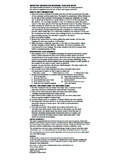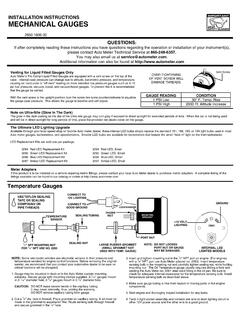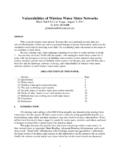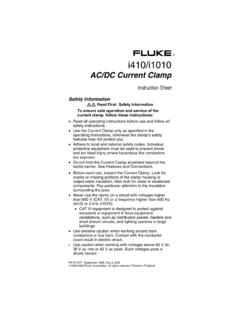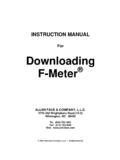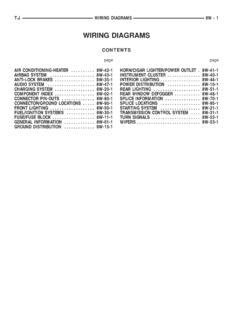Transcription of HOW TO USE YOUR SOIL pH METER - Luster Leaf
1 HOW TO USE your soil pH METER1. Remove the top 2" of the surface soil . Break up and crumble the soil underneath to a depth of 5". Remove any stones or organic debris such as leaves & twigs because they can affect the final result. Thoroughly wet the soil with water (preferably distilled) to a mud consistency. In order to obtain an even more accurat e result with your soil pH METER , t ak e the sample of soil to be tes ted from the ground and remove stones and organic debris. Prepare the sample by crumbling the soil into small particles. Measure 2 cups of soil from the prepared sample. Fill a clean glass or plastic container with 2 cups of distilled wat er and add the measured soil sample.
2 Ensure the soil and wat er are thoroughly mixed and compact the sample fir mly. Drain off excess wat er .2. Using the supplied pad, lightly shine 4"- 5" (10- 12cm) of the probe, carefully avoiding the bullet shaped tip, to remove any oxides that may have formed on the surface of the metal. Wipe the probe clean, using a cotton ball or paper tissue; always wipe away from the tip, towards the probe Push the probe vertically into the moistened soil to a depth of 4" 5". If it does not slip into the ground fairly easily select a new position. Never force the Twist the probe clockwise and counter-clockwise between your fingers several times to ensure that damp soil is well distributed over the surface of the Wait for 60 seconds to acclimatize the probe and note the If the reading is pH7 or higher: Remove the probe from the soil and wipe any soil particles from the surface of the probe.
3 Reshine the probe and insert back into the soil at a different point avoiding the first hole made by the probe. Twist the probe two or three times between the fingers, as before, and wait 30 seconds before taking the final If the reading is below pH7: Remove the probe from the soil and wipe any soil particles from the surface of the probe. Do not reshine the probe. Insert the probe back into the soil at a different point avoiding the first hole made by the probe. Twist the probe two or three times between the fingers, as before, and wait 60 seconds before taking the final ON TESTING Don t leave the probe in the soil longer than necessary because the metal electrodes may pit, with the possibility of damage to the METER mechanism.
4 Insure that the probe is wiped clean and well dried before storing in order to minimize the oxidation of the metal electrodes. Be sure to keep the probe away from metal objects. Use the METER only in soil . Do not place the probe into water. soil ADVICER aising and lowering pH is not an exact science and most plants have a reasonably wide pH tolerance, certainly to within 1 pH point. The long list of pH preferences below indicates that while a majority of plants can survive on a pH around , some need a particularly acid or alkaline soil . Altering pH takes time. Do not expect rapid changes. Work steadily towards giving a plant its ideal TYPESS andy Soils: A light, coarse soil comprised of crumbling and alluvial debris.
5 Loam Soils: A medium friable soil , consisting of a blend of coarse (sand) alluvium and fine (clay) particles mixed within fairly broad limits with a little lime and humus. Clay Soils: A heavy, clinging, impermeable soil , comprised of very fine particles with little lime and humus and tending to be waterlogged in winter and very dry in LIME TO INCREASE pHLime can be added at any time of year but it does need time to take effect which is why the autumn, winter and early spring are the preferred times. Hydrated lime may take effect in two or three months but ground chalk or limestone may take up to six months. Avoid adding lime at the same time as sulfate of ammonia, superphosphate, basic slag or animal manures.
6 Lime may be used in combination with sulfate of potash or muriate of CLEANING PADThe cleaning pad supplied with this METER has been specially selected for its compatibility with the METER probe metals. Other type of cleaners may cut or otherwise damage probe surfaces and/or adversely affect METER pads are available at a cost of $ for 3 pads, plus $ for postage and handling. Please send a check or money order, payable to Luster Leaf Products, Inc. to the address on the back of this card. No COD or phone orders, WARRANTYThe tester is warranted free from defects for one year from date of purchase. During this period the unit may be returned to Luster Leaf Products, Inc.
7 With proof of purchase and $ to cover postage and handling. It will be repaired or replaced. During the initial 90 days of this warranty period the selling dealer is also authorized to replace a defective warranty does not cover abuse, accidental damage, repair by anyone other than Luster Leaf Products, Inc., or consequential loss or inconvenience resulting from use of the warranty gives you certain specific legal rights and you may also have other rights which vary from state to adjustment or repair becomes necessary after the warranty expires, return the METER to Luster Leaf Products, Inc. with $ to cover postage, handling and service.
8 Service includes labor & parts as required, except for replacement of externally damaged or lost service, or information regarding otherLuster Leaf Products, Inc. items,please address: Luster Leaf Products, TechcourtWoodstock, Illinois 60098 TROUBLESHOOTINGE rratic needle movement Stones, organic matter t ouching the electrode. Sample area not suf ficiently compact ed(light soils and potting soils). Metal particles adhering to electrode after cleaning. soil not adhered to the probe sufficiently. Probe too close to the side and/or the bottom of the pot. soil or potting soil being tested too soon after r e-po tting.
9 A houseplant fertilizer stick or tablet near the probe. Sluggish or no response Probe requires cleaning. Sample area too dry. Damaged or pitted pH conditions (potted plants only) Nutrient build-up caused by o ver feeding. A houseplant fertilizer stick or tablet near the table gives approximate amounts to alter soil pH by up to 1 point up or down the pH pH Change Sandy Loamy ClayDolomitic or calcic limestone + unit ( pH) 5 +1 unit ( pH) 5 11 Hydrated Lime + unit ( pH) - 2 3 - 4 4 - +1 unit ( pH) - 4 6 - 8 - Sulfate unit ( pH) 2 -1 unit ( pH) 3 4 Aluminum Sulfate unit ( pH) - 1 - 1.
10 25 -1 unit ( pH) 1 - 1 .25 3 Amounts listed are pounds per 100 square feet. *Do not add more than 5lbs. of lime or sulfur in one PREFENCE LISTFLOWERS, TREES & SHRUBS ABELIA - - - - - - - - - - - - - - - - - - - - - - - - - FLOWER - - - HEART - - - - - BUSH - - - - - BELLS - FLOWER - - - - - - - - - - - - - - - - - - - - APPLE - - - - - LILY - - - - - - - - - - - - - - - - - - - - - - - ROD.
